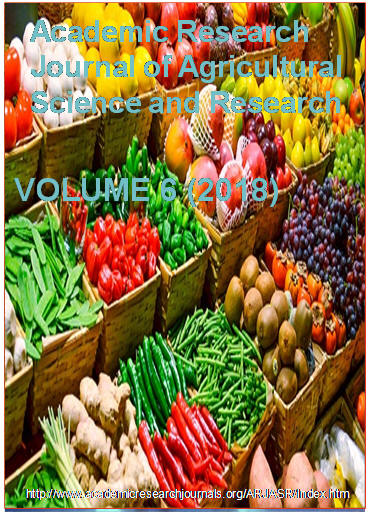| ARJASR |
Academic Research Journal of
Agricultural Science and Research |
||||||||||||||||||||||
|
Academic Research Journal of Agricultural Science and Research Vol. 6(5), pp. 291-298. June, 2018. ISSN: 2360-7874 DOI: 10.14662/ARJASRD2018.028 Full Length Research Evaluation of best performing indigenous Rhizobium inoculants for Chickpea (Cicer aritenium L.) production at Ginnir District, Bale Zone, Southeastern Ethiopia
Mulugeta Eshetu1, Tilahun Chibsa1, Negash Bedaso1, Shure Soboka2 and Chala Chimdessa1
1Sinana Agriculture Research Center (SARC), P.O. Box: 208, Bale-Robe, Ethiopia. 2Oromia Agricultural Research Institute, Food Science Directorate, Addis Ababa, Ethiopia *Corresponding author Mulugeta Eshetu, e-mail address: mulugeteshetu@gmail.com *Oromia Agricultural Research Institute , Sinana Agricultural Research Center, Soil Fertility Improvement and soil and Water Conservation Team, P. O. Box 208, Bale-Robe, Ethiopia.
Accepted 19 June 2018
Effectiveness of indigenous Rhizobium strains was selected and evaluated their ability for enhanced nodulation; grain yield and yield component of chickpea (Cicer aritenium L.) on farmers’ fields at Ebisa and Loboca, of Ginnir District. The experiment experiments were conducted for two consecutive crop-years at field condition from 2016 to 2017 during “Bona” cropping seasons. The seven treatments including control (without any fertilizer and inoculation), Inoculation of Strain 110, Strain 004 CP, Strain EAL29 with 36g/plot or 50kg/ha phosphorus were used. Experiment was laid out in a randomized complete-block (RCBD) design with three replications in which each treatment were applied on a plot size of 3m x 2.4m =7m2, the distance between blocks and within plots are 1.5 m. Test crop chickpea (Ararti vertices) 48.8 g/plot or 65kg/ha, were used. The results this studies indicated that yield and yield component of chickpea (Cicer ariеtinum L.) were significantly influenced by the application of rhizobium inoculation and phosphorus fertilizer. The results show that significantly higher grain yield were obtained under Rhizobium inoculants combined with phosphorus fertilizer ( EAL29 + 50 kg ha-1 DAP) over the control in which recorded 51.61% higher grain yield (4.7 t ha−1 ) as compared to control (3.1 t ha−1 ). From the result of this studies it can be concluded that the effect and interaction of rhizobium, and phosphorus fertilizer (50kgha-1 DAP) which contain 9kgha-1 N as starter significantly increased yield of chickpea under for the study area.
Keywords: Rhizobium Inoculation; Chickpea; fertilizer DAP; Grain yield
How to cite this article: Eshetu M, Chibsa T, Bedasso N, Sebboka S, Chimdessa C (2018). Evaluation of best performing indigenous Rhizobium inoculants for Chickpea (Cicer aritenium L.) production at Ginnir District, Bale Zone, Southeastern Ethiopia. Acad. Res. J. Agri. Sci. Res. 6(5): 291-298
|
|
|||||||||||||||||||||
